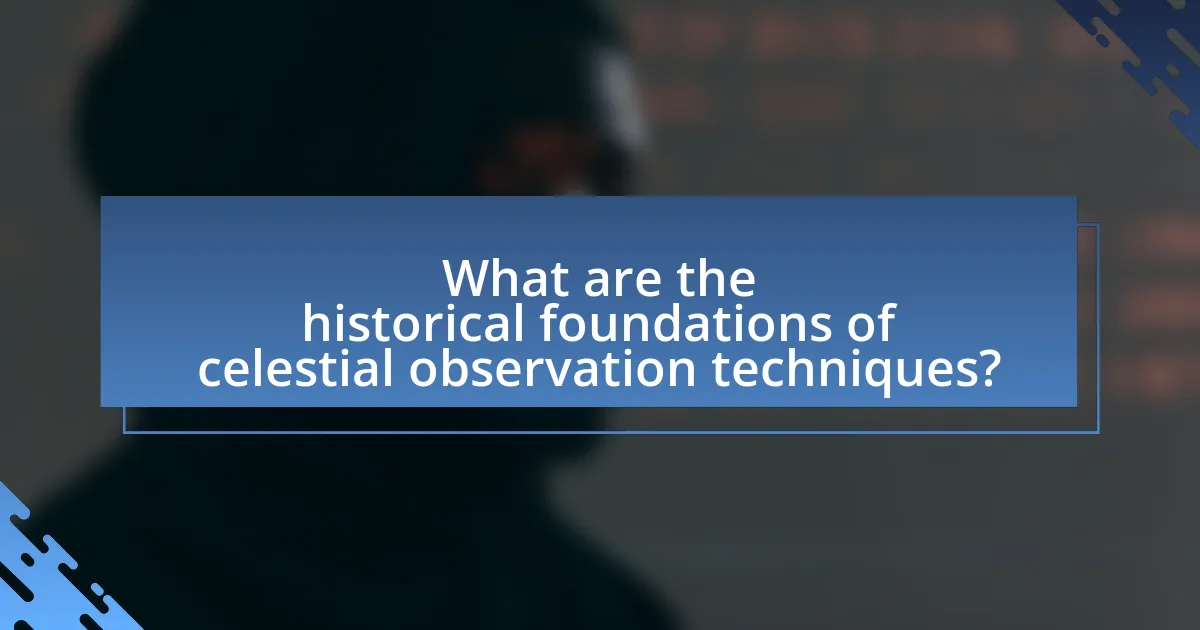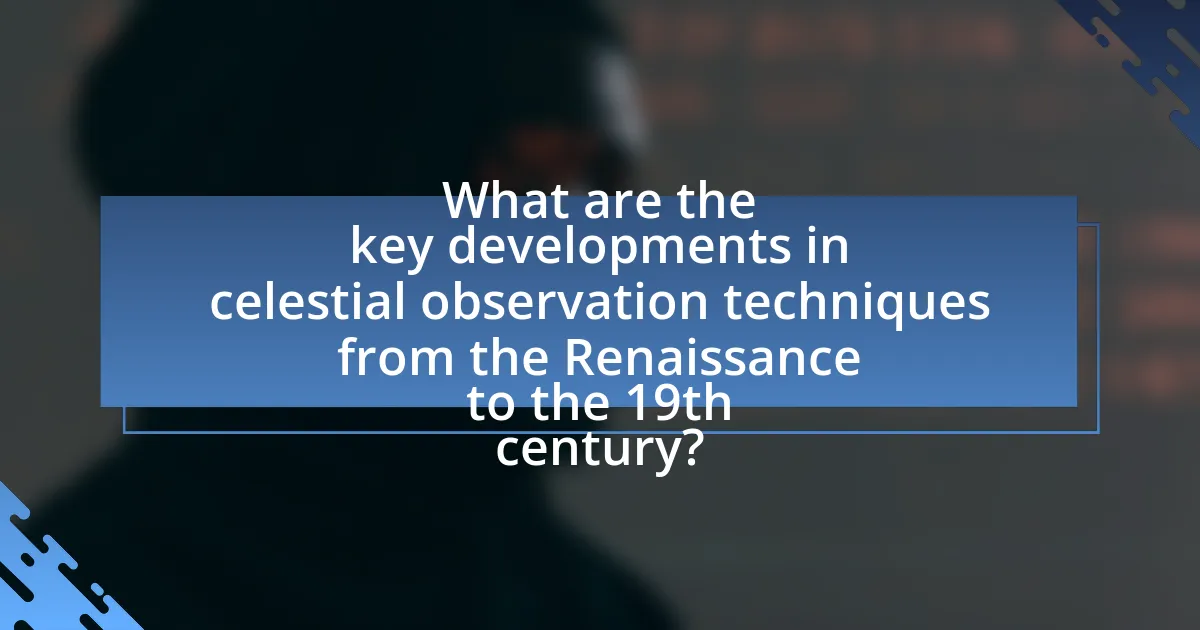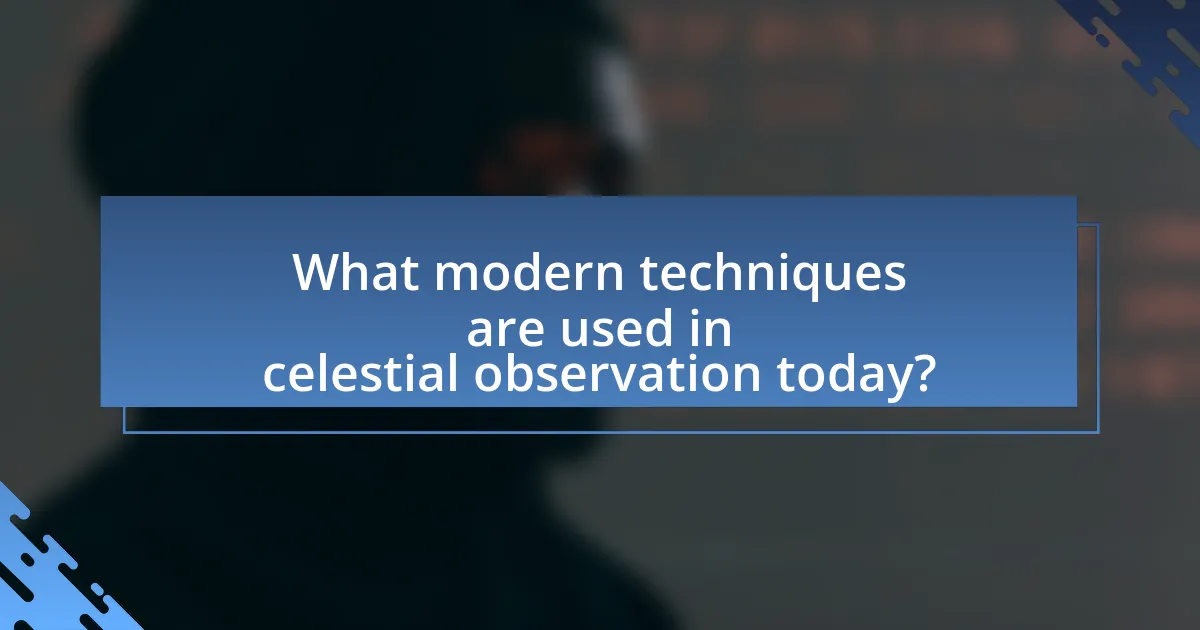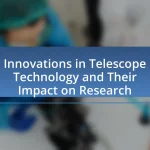The article examines the evolution of celestial observation techniques from ancient civilizations to modern times. It highlights the contributions of the Babylonians, Greeks, and Chinese in developing early observational methods and tools, such as the gnomon and armillary sphere. The advancements made during the Middle Ages, particularly by Islamic scholars, are discussed, along with the transformative impact of the telescope in the 17th century. Key developments from the Renaissance to the 19th century, including the shift to heliocentric models and technological innovations, are outlined. The article also addresses contemporary challenges in celestial observation, such as light pollution and atmospheric interference, while emphasizing modern techniques like adaptive optics and space-based telescopes that enhance our understanding of the universe.

What are the historical foundations of celestial observation techniques?
The historical foundations of celestial observation techniques are rooted in ancient civilizations, particularly those of the Babylonians, Greeks, and Chinese, who developed early methods for tracking celestial bodies. The Babylonians, around 2000 BCE, created detailed star catalogs and used simple observational tools like the gnomon to track the sun’s movement. The Greeks, notably Hipparchus in the 2nd century BCE, advanced these techniques by introducing the concept of celestial spheres and developing the first star catalog based on systematic observations. Chinese astronomers, with records dating back to 1000 BCE, also made significant contributions, including the invention of the armillary sphere, which allowed for more precise tracking of celestial movements. These foundational techniques laid the groundwork for modern astronomy, demonstrating the evolution of celestial observation from rudimentary methods to more sophisticated instruments over centuries.
How did ancient civilizations observe celestial bodies?
Ancient civilizations observed celestial bodies primarily through naked-eye observations and the use of simple tools like gnomons and early astrolabes. These methods allowed them to track the movements of stars, planets, and the moon, which were crucial for agricultural calendars and navigation. For instance, the Babylonians meticulously recorded celestial events on clay tablets, leading to the development of early astronomy. Similarly, the Egyptians aligned their pyramids with specific stars, demonstrating their understanding of celestial positioning. These practices laid the groundwork for more advanced astronomical techniques in later civilizations.
What tools and methods did early astronomers use?
Early astronomers used tools such as the astrolabe, armillary sphere, and telescopes, along with methods like naked-eye observation and star charts. The astrolabe allowed for the measurement of celestial bodies’ positions, while the armillary sphere provided a model of the celestial sphere for educational purposes. The invention of the telescope in the early 17th century by figures like Galileo revolutionized astronomy by enabling detailed observations of celestial objects. Historical records indicate that these tools and methods significantly advanced the understanding of the cosmos, leading to discoveries such as the moons of Jupiter and the phases of Venus.
How did cultural beliefs influence celestial observation?
Cultural beliefs significantly influenced celestial observation by shaping the interpretation and significance of celestial phenomena. For instance, ancient civilizations like the Babylonians and Egyptians viewed celestial bodies as deities or omens, which led them to meticulously record astronomical events to predict agricultural cycles and religious festivals. This belief system drove the development of early astronomical techniques, such as the creation of calendars based on lunar and solar cycles, which were essential for societal organization. Additionally, in cultures like the Mayans, celestial observations were intertwined with mythology, resulting in advanced mathematical models to predict celestial events, demonstrating how cultural narratives directly impacted the sophistication of their astronomical practices.
What advancements occurred during the Middle Ages?
During the Middle Ages, significant advancements in celestial observation techniques emerged, particularly through the development of astronomical instruments and the refinement of observational methods. The introduction of the astrolabe, a device used for solving problems related to time and the position of the stars, allowed astronomers to make more accurate measurements of celestial bodies. Additionally, the construction of observatories, such as those in Islamic regions, facilitated systematic observations of the night sky, leading to improved star catalogs and the understanding of planetary motion. Notably, figures like Al-Battani and Tycho Brahe contributed to these advancements by providing precise astronomical data that challenged existing geocentric models.
How did Islamic scholars contribute to astronomy?
Islamic scholars significantly advanced astronomy through the development of precise astronomical instruments and the establishment of observatories. They created tools such as the astrolabe and the quadrant, which improved the accuracy of celestial measurements. Notably, scholars like Al-Battani and Al-Farghani made substantial contributions to the understanding of planetary motion and the calculation of the Earth’s circumference, with Al-Battani’s work influencing later European astronomers. The translation and preservation of Greek astronomical texts by Islamic scholars also played a crucial role in the transmission of knowledge, ensuring that foundational concepts in astronomy were not lost and were further developed during the Islamic Golden Age.
What role did the invention of the telescope play in this era?
The invention of the telescope revolutionized celestial observation by enabling astronomers to see distant celestial bodies with unprecedented clarity. This advancement allowed for significant discoveries, such as Galileo’s identification of Jupiter’s moons in 1610, which provided evidence against the geocentric model of the universe. The telescope’s ability to magnify distant objects fundamentally changed the understanding of the cosmos, leading to the acceptance of the heliocentric model proposed by Copernicus and furthering the scientific revolution.

What are the key developments in celestial observation techniques from the Renaissance to the 19th century?
Key developments in celestial observation techniques from the Renaissance to the 19th century include the invention of the telescope, advancements in astronomical mapping, and the establishment of observatories. The telescope, first improved by Galileo in the early 17th century, allowed for detailed observations of celestial bodies, revealing moons of Jupiter and the phases of Venus. This period also saw the creation of more accurate star charts, exemplified by Johannes Kepler’s work, which laid the groundwork for modern astronomy. Furthermore, the establishment of observatories, such as the Greenwich Observatory in 1675, facilitated systematic observations and data collection, significantly enhancing the understanding of celestial phenomena. These developments collectively transformed astronomy from a philosophical discipline into a rigorous scientific field.
How did the Renaissance spark a new era in astronomy?
The Renaissance sparked a new era in astronomy by promoting a shift from geocentric to heliocentric models, fundamentally changing the understanding of the cosmos. This transformation was exemplified by Nicolaus Copernicus, whose 1543 work “De revolutionibus orbium coelestium” proposed that the Earth and other planets revolve around the Sun, challenging the long-held Ptolemaic system. Additionally, advancements in observational technology, such as the telescope invented by Galileo Galilei in the early 17th century, allowed for more precise celestial observations, leading to significant discoveries like the moons of Jupiter and the phases of Venus. These developments laid the groundwork for modern astronomy, emphasizing empirical evidence and observation over established dogma.
What were the major discoveries made during this period?
The major discoveries made during the evolution of celestial observation techniques include the invention of the telescope in the early 17th century, which allowed astronomers like Galileo to observe celestial bodies in unprecedented detail, revealing the moons of Jupiter and the phases of Venus. Additionally, the development of spectroscopy in the 19th century enabled scientists to analyze the composition of stars and galaxies, leading to the understanding of stellar evolution and the expansion of the universe. The advent of photography in the 19th century further advanced celestial observation by capturing detailed images of celestial phenomena, such as nebulae and star clusters, which were previously impossible to document. These discoveries collectively transformed our understanding of the universe and laid the groundwork for modern astrophysics.
How did the heliocentric model change celestial observation?
The heliocentric model fundamentally transformed celestial observation by positioning the Sun at the center of the solar system, which allowed for a more accurate understanding of planetary motions. This model, proposed by Nicolaus Copernicus in the 16th century, replaced the geocentric view that placed Earth at the center, leading to significant advancements in astronomical techniques. The heliocentric model facilitated the development of more precise observational tools, such as the telescope, and encouraged astronomers like Johannes Kepler to formulate laws of planetary motion based on empirical data, thus enhancing the accuracy of celestial navigation and observation. The shift to a heliocentric perspective also prompted a reevaluation of the cosmos, ultimately laying the groundwork for modern astronomy and the scientific method.
What technological innovations emerged in the 18th and 19th centuries?
Technological innovations that emerged in the 18th and 19th centuries include the development of the telescope, the invention of the steam engine, and advancements in photography. The telescope, significantly improved by figures like William Herschel, allowed for more detailed celestial observations, leading to the discovery of Uranus in 1781. The steam engine, perfected by James Watt in the late 18th century, revolutionized transportation and industry, facilitating the movement of goods and people, which indirectly supported astronomical research. Additionally, the invention of photography in the 19th century by Louis Daguerre and others enabled the capture of celestial images, enhancing the documentation and study of astronomical phenomena. These innovations collectively advanced the field of celestial observation and contributed to the scientific understanding of the universe.
How did improved telescopes enhance our understanding of the universe?
Improved telescopes significantly enhanced our understanding of the universe by allowing astronomers to observe celestial objects with greater clarity and detail. For instance, the introduction of the Hubble Space Telescope in 1990 provided high-resolution images of distant galaxies, nebulae, and other astronomical phenomena, revealing structures and compositions that were previously undetectable. This advancement led to breakthroughs such as the discovery of the accelerating expansion of the universe, supported by observations of distant supernovae. Additionally, advancements in adaptive optics and radio telescopes have enabled the study of exoplanets and cosmic microwave background radiation, further deepening our comprehension of the universe’s origins and evolution.
What impact did photography have on celestial observation?
Photography revolutionized celestial observation by enabling astronomers to capture detailed images of celestial bodies, which enhanced the accuracy of their studies. Prior to photography, celestial observations relied heavily on sketches and visual estimates, which were often subjective and limited in detail. The introduction of photographic techniques in the 19th century allowed for longer exposure times, resulting in clearer and more precise images of stars, planets, and other astronomical phenomena. For instance, the first successful astronomical photograph was taken in 1840 by John William Draper, capturing the Moon’s surface, which marked a significant advancement in the field. This shift not only improved the documentation of celestial events but also facilitated the discovery of new celestial objects, as seen with the identification of the asteroid Eros in 1898 through photographic plates. Thus, photography fundamentally transformed celestial observation by providing a reliable method for capturing and analyzing the universe.

What modern techniques are used in celestial observation today?
Modern techniques used in celestial observation today include adaptive optics, radio interferometry, and space-based telescopes. Adaptive optics corrects for atmospheric distortion in real-time, allowing ground-based telescopes to achieve higher resolution images, as demonstrated by the Keck Observatory in Hawaii. Radio interferometry combines signals from multiple radio telescopes to create detailed images of celestial objects, exemplified by the Very Large Array in New Mexico. Space-based telescopes, such as the Hubble Space Telescope, eliminate atmospheric interference entirely, providing clear and unobstructed views of the universe. These advancements have significantly enhanced our ability to observe and understand celestial phenomena.
How has technology transformed celestial observation in the 20th and 21st centuries?
Technology has significantly transformed celestial observation in the 20th and 21st centuries through advancements in telescopes, imaging techniques, and data analysis. The introduction of radio telescopes in the mid-20th century allowed astronomers to detect celestial objects emitting radio waves, expanding the observable universe beyond visible light. The Hubble Space Telescope, launched in 1990, provided unprecedented clarity and detail in astronomical images, leading to discoveries such as the acceleration of the universe’s expansion. Additionally, the development of adaptive optics has improved ground-based telescopes’ ability to counteract atmospheric distortion, enhancing image quality. Furthermore, the rise of digital imaging and data processing has enabled the analysis of vast amounts of astronomical data, facilitating discoveries in exoplanet research and cosmic background radiation. These technological advancements have collectively revolutionized our understanding of the universe.
What role do satellites play in modern astronomy?
Satellites play a crucial role in modern astronomy by providing high-resolution images and data from space, which enhance our understanding of celestial phenomena. These satellites, such as the Hubble Space Telescope and the Chandra X-ray Observatory, operate outside Earth’s atmosphere, allowing them to capture clearer and more detailed observations of distant galaxies, stars, and other astronomical objects. For instance, Hubble has contributed to significant discoveries, including the measurement of the expansion rate of the universe and the identification of exoplanets. The data collected by these satellites is essential for advancing astronomical research, enabling scientists to study cosmic events and the structure of the universe with unprecedented accuracy.
How do radio telescopes differ from optical telescopes?
Radio telescopes differ from optical telescopes primarily in the type of electromagnetic radiation they detect; radio telescopes capture radio waves, while optical telescopes observe visible light. This fundamental difference allows radio telescopes to study celestial objects that are often obscured by dust and gas, which can block visible light, enabling the exploration of phenomena such as pulsars and cosmic microwave background radiation. Additionally, radio telescopes typically have larger dish sizes to collect the longer wavelengths of radio waves, whereas optical telescopes use lenses or mirrors to focus light. This distinction in design and function highlights the complementary roles both types of telescopes play in advancing our understanding of the universe.
What are the challenges faced in contemporary celestial observation?
Contemporary celestial observation faces several challenges, including light pollution, atmospheric interference, and the limitations of current technology. Light pollution, primarily from urban areas, obscures faint celestial objects, making it difficult for astronomers to conduct observations. Atmospheric interference, such as turbulence and weather conditions, can distort images and hinder data collection. Additionally, existing telescopes and instruments may not have the sensitivity or resolution needed to detect increasingly distant or dim celestial phenomena, which limits the scope of astronomical research. These challenges necessitate ongoing advancements in observational technology and techniques to enhance the quality and quantity of data collected from the universe.
How does light pollution affect astronomical studies?
Light pollution significantly hinders astronomical studies by obscuring celestial objects and reducing the visibility of faint astronomical phenomena. This interference occurs because artificial lighting increases the background brightness of the night sky, making it difficult for astronomers to detect dim stars, galaxies, and other celestial bodies. For instance, research indicates that light pollution can diminish the visibility of stars by up to 90% in urban areas, severely limiting observational capabilities. Consequently, astronomers rely on dark-sky locations for accurate data collection, as these areas provide clearer views of the universe, essential for advancing our understanding of cosmic events and structures.
What are the limitations of current observation techniques?
Current observation techniques face several limitations, including resolution constraints, atmospheric interference, and technological accessibility. Resolution constraints hinder the ability to discern fine details in celestial objects, as many telescopes are limited by their aperture size and the diffraction limit. Atmospheric interference, particularly from Earth’s atmosphere, distorts images and reduces clarity, impacting ground-based observations significantly. Additionally, technological accessibility restricts the use of advanced observation tools to well-funded institutions, limiting broader scientific participation and discoveries. These limitations collectively affect the accuracy and comprehensiveness of celestial observations.
What practical tips can enhance celestial observation experiences?
To enhance celestial observation experiences, individuals should utilize a telescope or binoculars for improved visibility of celestial bodies. Using these tools allows observers to see details such as craters on the Moon or the rings of Saturn, which are not visible to the naked eye. Additionally, selecting a dark location away from city lights significantly reduces light pollution, enhancing the clarity of the night sky. According to the International Dark-Sky Association, dark-sky locations can increase visibility of celestial objects by up to 10 times compared to urban areas. Furthermore, planning observations around astronomical events, such as meteor showers or eclipses, can provide unique and memorable experiences. Engaging with local astronomy clubs or online communities can also offer valuable insights and tips from experienced observers, enriching the overall experience.


